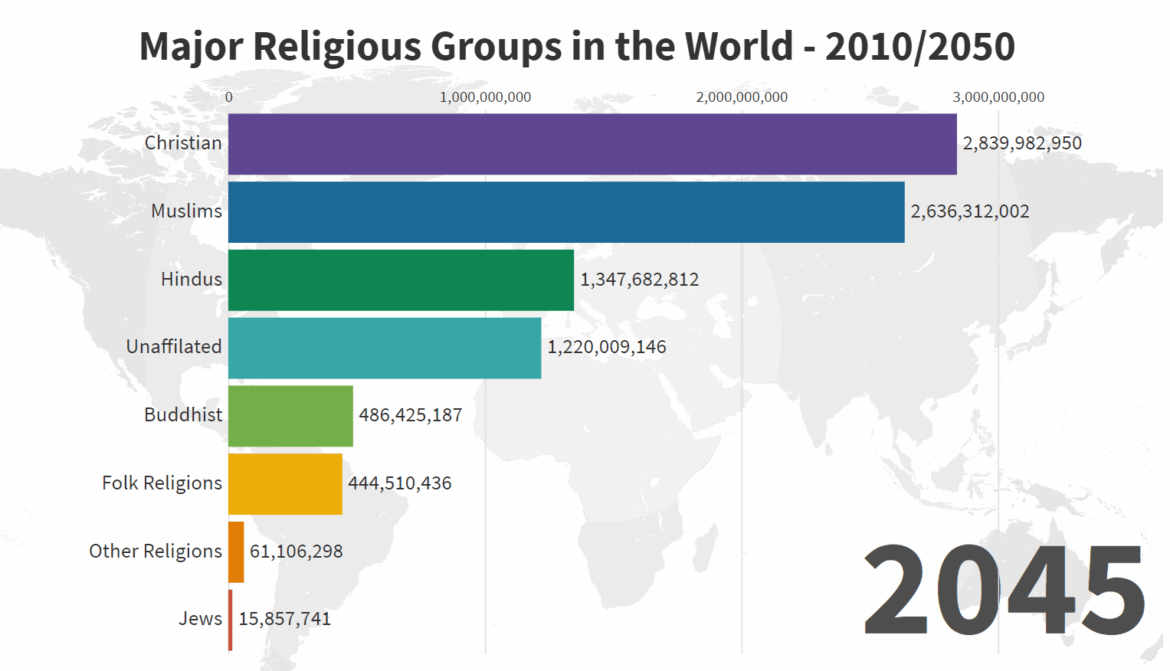The world’s landscape of faith is remarkably diverse, imbued with intricate beliefs, practices, and traditions that shape countless lives. A pivotal question often arises: which religion boasts the most followers globally? This query, while seemingly straightforward, opens the gateway to a profound exploration of societal dynamics and individual convictions. Nestled within this inquiry are layers of complexity, interwoven with historical, sociopolitical, and cultural threads that warrant a contemplative examination.
As of recent estimations, Christianity emerges as the largest religion, claiming a significant portion of the global population. Comprising numerous denominations, such as Catholicism, Protestantism, and Orthodoxy, Christianity’s demographic reach is expansive. This wide array of beliefs under a singular umbrella facilitates an extensive dialogue among different branches, enriching the faith and expanding its influence across continents.
The essence of Christianity is rooted in the teachings of Jesus Christ, whose life, death, and resurrection serve as foundational tenets. Central to Christian doctrine is the belief in salvation and the transformative power of faith. These tenets resonate deeply within adherents, nurturing a community forged from love, hope, and a shared sense of purpose. As the world’s population grows, the tenacity of Christian faith remains steadfast, drawing individuals towards the promise of eternal life and fellowship with the divine.
However, Christianity’s extensive follower count raises intriguing inquiries: what factors contribute to its proliferation across diverse cultures? One may draw attention to the missionary zeal exhibited throughout history, where dedicated individuals traversed vast territories to evangelize the message of Christ. This zeal, often intertwined with colonial enterprises, allowed Christianity to set deep roots in numerous regions, particularly in Africa and Asia. The propagation of faith through missions not only expanded the Christian community but also introduced varying cultural interpretations of core beliefs.
Moreover, the role of adaptability in the face of changing societal landscapes cannot be overlooked. Christianity has demonstrated a remarkable capacity to resonate with diverse cultures while retaining its foundational principles. This adaptability has enabled the faith to thrive amid a plethora of ideologies and lifestyles, cultivating a rich tapestry of expressions encompassing African traditional religions, indigenous practices, and contemporary spiritual movements. Through dialogue and contextualization, Christianity’s core message transcends cultural barriers, fostering connection amongst disparate societies and forming a universal kinship.
Nevertheless, one ought to consider the juxtaposition of Christianity with other religions. Islam, the second-largest faith, has also experienced significant growth, particularly in the 21st century. With its adherents primarily centered in the Middle East, North Africa, and parts of Asia, Islam fosters a profound sense of community through communal rituals and shared beliefs. The tenets of Islam, emphasizing submission to the will of Allah and adherence to the Five Pillars, imbue Muslims with a distinct identity that cultivates fervent loyalty and devotion.
The dynamism of faith, however, extends beyond mere numbers. It encapsulates the essence of human experience—an endeavor to find meaning, purpose, and belonging. The fascination surrounding the demographics of religions often underscores deeper existential queries. In an increasingly secular world, where empirical evidence frequently supplants spiritual conviction, individuals grapple with the quest for truth and the yearning for connection. Such pursuits propel people towards organized religions, which offer structured frameworks for navigating life’s complexities.
Moreover, sociopolitical factors sway religious demographics. Migration patterns, conflict, and globalization significantly impact the religious landscape. For instance, the refugee crises and migration driven by war and poverty have led to significant demographic shifts, where adherents of various faiths encounter one another in novel contexts. This interplay inspires interfaith dialogue, fostering mutual understanding or, conversely, exacerbating sectarian tensions. Globalization promotes the exchange of ideas and belief systems, amplifying the quest for spiritual fulfillment in diverse communities. As individuals navigate these complex landscapes, they often cling to faith as a stabilizing force amid uncertainty.
The question of populated religions intertwines with issues of identity and belonging. For many, faith is not merely a doctrinal belief; it evokes a profound sense of belonging to a collective narrative shared with others. The communal aspects of worship, service, and charitable engagements foster bonds, creating a robust network of support that transcends individual needs and inspires collective action. This sense of affinity propels the growth of faith, allowing individuals to find solace, encouragement, and purpose within a spiritual family.
In contrast, the rise of secularism presents an intriguing counter-narrative. Increasingly, individuals detach from traditional religious affiliations, gravitating towards alternative spiritual practices or embracing secular humanism. This trend challenges the conventional paradigms of faith, prompting discussions regarding the roles of spirituality and belief in contemporary society. It beckons a contemplation of what it means to be rooted in faith in a world steeped in relativism.
Thus, as we ponder the question of populated religions, we unveil a richly woven narrative that encompasses history, culture, individual experiences, and societal dynamics. Christianity, with its multitude of followers, stands as a testament to the enduring search for meaning within the human experience. Amidst the populous embrace of various faiths, it becomes increasingly clear that the quest for understanding, purpose, and connection remains a quintessential aspect of life, manifesting uniquely across different sects and traditions.
Ultimately, the quest to understand which faith possesses the most followers transcends statistics, inviting a more profound exploration of human connection. In a world rife with division and diversity, the pursuit of understanding and unity within the tapestry of belief serves as an invaluable catalyst for dialogue, compassion, and ultimately, a more harmonious existence.



